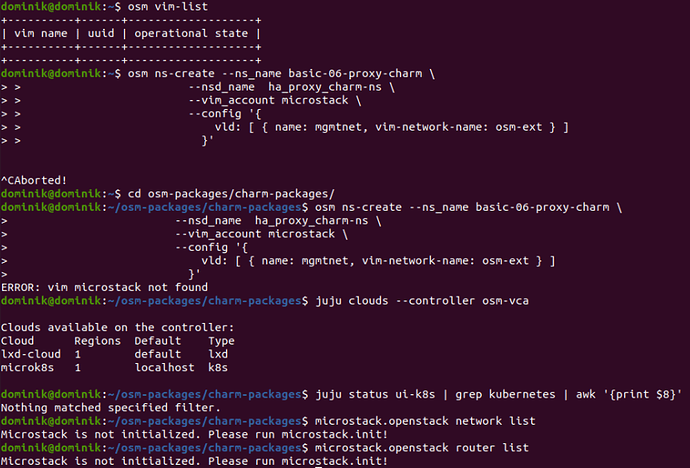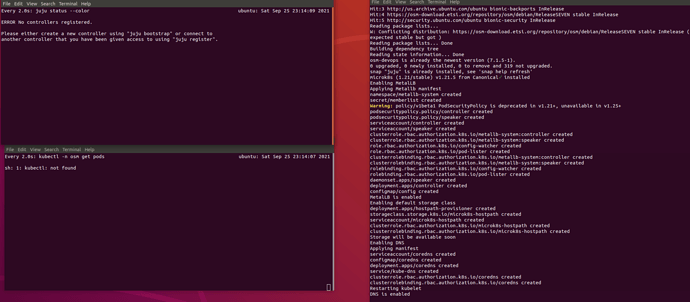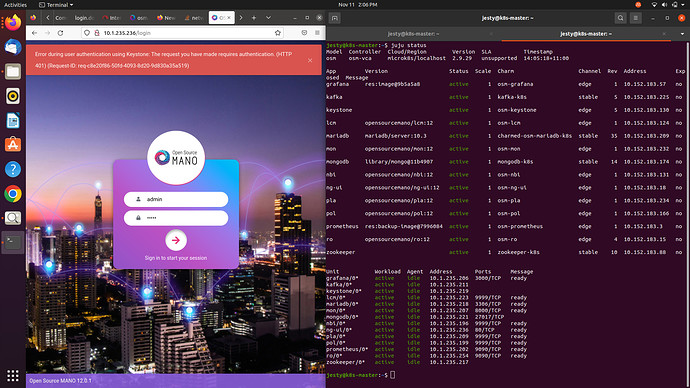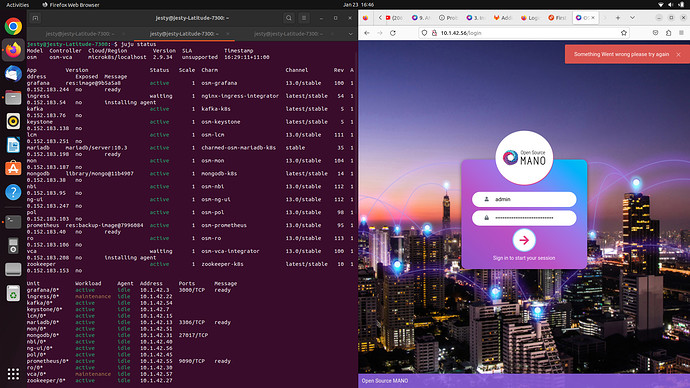Thanks, i will try installing version nine according to the instructions suggested
Same as the others, I tried but it didn’t work. I just tried with version nine but I got the “permanently dropping privs did not work: File exists” which looks like an intermittent issue. I will re-try again…
Hi all!
I followed tutorial : Juju | The simplest way to deploy and maintain applications in the cloud
and noticed that I have differences between outputs from tutorial and my outputs:
- After typing command ‘juju clouds --controller osm-vca’ I got only lxd-cloud and microk8s
- After typing command ‘juju status ui-k8s | grep kubernetes | awk ‘{print $8}’’ I got zero matches
- After typing commands ‘microstack.openstack network list’ and ‘microstack.openstack router list’, commands were not found
- After typing ‘osm vim-list’, output didn’t list any vim
Other outputs from step ‘understanding installation steps’ (linked in first line) are fine.
I installed microstack using snap, but I don’t know how to connect microstack with osm the way it should be done during installation osm charmed.
- Now when I try to follow steps https://juju.is/tutorials/charmed-osm-get-started#4-onboarding-vnfs I cannot create basic NS, because of vim microstack not found.
osm ns-create --ns_name basic-06-proxy-charm
–nsd_name ha_proxy_charm-ns
–vim_account microstack
–config ‘{
vld: [ { name: mgmtnet, vim-network-name: osm-ext } ]
}’
I attached screenshot with outputs. Does anyone have an idea what should I do, if this differences are normal and how I can connect vim microstack with osm? Thanks for help in advance.
Hi
I was installing OSM on Ubuntu 18.04 (8CPU/16GB RAM/ 80GB HDD/Single VM running over VMware workstation). It is stuck in DNS enabled. I followed this post not sure what is wrong, can you please suggest. Please see the status.
Thank you
Best Regards
K
Hello,
I’m trying to install OSM v10 by using ./install_osm.sh -R ReleaseTEN --charmed and the deployment is pending just after the microk8s installation. Is anybody facing the same issue?
I’m attaching a screenshot for your reference:
Thanks in advance.
Hi,
When I deploy charmed OSM in OpenStack, I have to assign a floating ip for me to access the VM. May I ask how can I expose external ip to OSM so that I can access the services such as web ui, grafana etc.?
When I ran sudo microk8s.kubectl describe ingress -n osm it shows me internal hostname. However I need external hostname that uses the floating point ip. How can I do that?
Thanks, James
HI, I was trying to install OSM in Ubuntu 20.04. I am facing an error while giving authentication for OSM user interface. Could you please suggest me where I went wrong. Please see the screenshot of the error and juju status below.
Hello,
Charmed OSM changes the default password for security reasons. In the installation log the password you need to use is shown, but you can get it with this command:
juju config keystone admin-password
Use that password to log in the UI.
For the CLI you can set the password with the following command:
export OSM_PASSWORD=`juju config keystone admin-password`
Please, let me know if that fixes your problem.
Best regards,
Guillermo
Thank you for the suggestion Guillermo.
Regards, Jesty Mariam
Hi, I am trying to install osm charmed with microstack but I get this error when I am trying to use osm command (28, ‘Resolving timed out after 15000 milliseconds’) Maybe “–hostname” option or OSM_HOSTNAME environment variable needs to be specified Please refer to the screenshot below. Please let me know where I went wrong.
Did you export the OSM_HOSTNAME and OSM_PASSWORD environment variables? That information is printed out at the end of the installation.
Hello,
I’m trying to install OSM in Windows 11 with a multipass VM, following the info in How to get started with Charmed OSM
The last outputs of the command “./install_osm.sh --charmed” are the following:
...
Track k8scluster k8scluster_ok: https://osm.etsi.org/InstallLog.php?&installation_id=1673735435-It5UNJL3mrTmrqJm&local_ts=1673735840&event=k8scluster&operation=k8scluster_ok&value=&comment=&tags=
juju (2.9/stable) 2.9.37 from Canonical** installed
Track juju juju_ok: https://osm.etsi.org/InstallLog.php?&installation_id=1673735435-It5UNJL3mrTmrqJm&local_ts=1673736109&event=juju&operation=juju_ok&value=&comment=&tags=
Enabling MetalLB
Applying Metallb manifest
Warning: policy/v1beta1 PodSecurityPolicy is deprecated in v1.21+, unavailable in v1.25+
E0114 23:53:17.817290 9393 request.go:1101] Unexpected error when reading response body: http2: client connection lost
error when retrieving current configuration of:
Resource: "/v1, Resource=namespaces", GroupVersionKind: "/v1, Kind=Namespace"
Name: "metallb-system", Namespace: ""
from server for: "STDIN": Get "https://127.0.0.1:16443/api/v1/namespaces/metallb-system": http2: client connection lost
...
Any hint how to fix this error?
— Edit —
The situation doesn’t change not using multipass, but running the installation in a partition or a standalone Ubuntu PC. The results of the intermediate installation steps are
$ juju status
Model Controller Cloud/Region Version SLA Timestamp
osm osm-vca microk8s/localhost 2.9.29 unsupported 18:24:10+01:00
Model "admin/osm" is empty.
$ microk8s.kubectl -n osm get all -n osm
NAME READY STATUS RESTARTS AGE
pod/modeloperator-866bfb7db9-vhz64 1/1 Running 2 (9m56s ago) 149m
NAME TYPE CLUSTER-IP EXTERNAL-IP PORT(S) AGE
service/modeloperator ClusterIP 10.152.183.201 <none> 17071/TCP 149m
NAME READY UP-TO-DATE AVAILABLE AGE
deployment.apps/modeloperator 1/1 1 1 149m
NAME DESIRED CURRENT READY AGE
replicaset.apps/modeloperator-866bfb7db9 1 1 1 149m
So grafana, kafka and statefulset.apps are missing
Thanks, Pietro
I am seeing the same error. Were you able to resolve the issue
hello @davigar I am trying to install charmed OSM on UBUNTU 20.04 by following the steps Any help would be appreciated here
ubuntu@mano:~$ ./install_osm.sh --charmed
Checking required packages to add ETSI OSM debian repo: software-properties-common apt-transport-https
OK …
clusterrole.rbac.authorization.k8s.io/coredns created
clusterrolebinding.rbac.authorization.k8s.io/coredns created
Restarting kubelet
DNS is enabled
Microk8s storage failed to enable
microk8s is not running. Use microk8s inspect for a deeper inspection.
Wed 18 Jan 2023 09:24:23 PM UTC bootstrap_k8s_lxd: FATAL error: bootstrap_k8s Microk8s storage failed to enable
Hi, My OSM interface was working properly but all of a sudden I am unable to access the OSM UI. It is showing something went wrong as an error.
Please help me where I went wrong. Please find the screenshot for reference.
Hello,
Maybe a dumb question, but how you get back this information? Is it possible to get just the last part to export properly or we should REDO the overall deployment?
Thanks, Nicolas
Answering to my own question 
And it worked, but in UI I see the operational status in ERROR state.
Edit : The best fitted answer is more like
export OSM_PASSWORD='juju config keystone admin-password'
export OSM_HOSTNAME='juju config nbi site_url'
But I think that there is missing the 443 port and we shouldn’t request to HTTPS, am i wrong?
Hello Pietro
Looks like there was an issue with your installation of microk8s. Could you provide the output of the microk8s status command?
You can try to reinstall osm, but I would try to do it in a clean VM.
I suggest you to follow this tutorial: Installation tutorial
Hello Suresh
The same answer that I provided to Pietro.
Looks like there was an issue with your installation of microk8s. Could you provide the output of the microk8s status command?
You can try to reinstall osm, but I would try to do it in a clean VM.
I suggest you to follow this tutorial: Installation tutorial
Hello Nicolas
You are right, you need to add the port 443 and remove the “https://” if you are installing an OSM in release 12 or before.
In case you install release 13, the command would be juju config nbi external-hostname, and the returned value doesn’t contain “https://”
I hope that helps.





